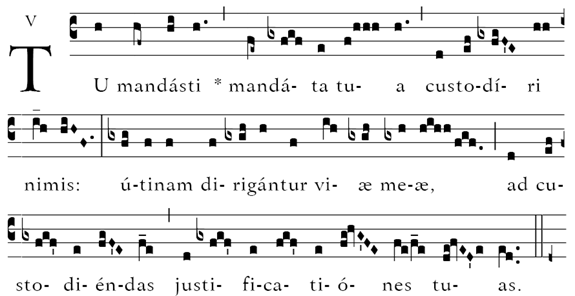Next weekend’s communion chant for the 25th Sunday of the Year is Tu Mandasti, and we worked on it last night in our schola rehearsal. I just have to confess that it is one of my absolute favorites, and for two reasons.
First, the chant is about how we’ve been commanded to keep God’s commandments, which you might think would yield a chant that is solemn and stern, since we are being told about law.
But look: the chant is in mode 5, a major mode, a joyful mode, a mode that evokes a sort of carefree celebration of life. Why? Why did the monks choose a happy mode in which to set this text from Psalm 118? Well, if you know monks, you know that they are the happiest of people, quick to laugh and light in their demeanor. It must have always been that way. What liberates them from the cares of the world? The law of God, the order of their day, the rule.
The rule and the guidelines is what grants the sense of freedom: one of the greatest paradoxes of the Christian life. It is something we can all enjoy provided we cling to the rule. The law is what gives us freedom. Here it is in song.

Second, look at the second half. “That I might be firm in the ways of keeping your statutes.” Now look at the way the notes are arranged on the last line. It looks like a path, doesn’t it? It sounds like a path, the way you might arrange stones in your backyard, one stone this way, another one that way. It covers very little ground side to side (see the repeated use of the la te figure) but the motion is always forward, in a way that is comfortable to walk on, one foot in front of the other, sometimes almost as if skipping with glee. Here is the musical path, all the way to the end.
Wonderful, isn’t it? You can say that this is my wild imagination at work, but once you see it and hear it can you forget it?
Here is a hard copy. And here is a book of communion antiphons with Psalms.

You're right about the 'skipping', certainly.
Sort of a SOBER skipping–altogether appropriate.
The music theorist in me also noticed all of the tis are flatted, making them tes. Make one wonder if this was transposed.
Maybe it's the fact I live in the 21st century, but whenever I see a chant like this in Mode V with every ti flatted, I just hear it in major! – with fa as do.
Rich, exactly. This is how I am learning it myself, as I will be chanting it at next weekend's Mass as well as the Introit (along with another person).